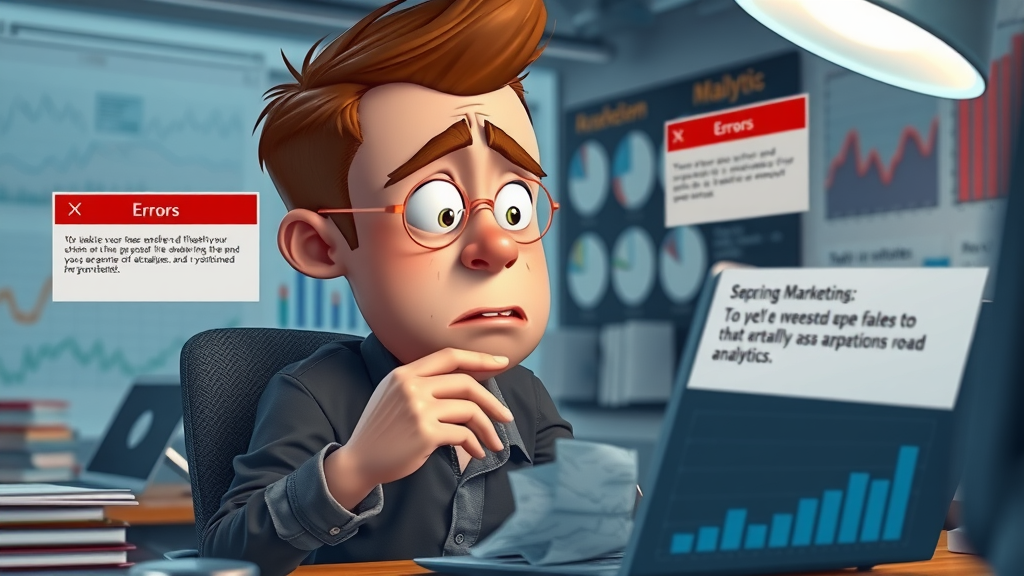Did you know that 72% of marketers say targeted content creation is their most effective strategy for engaging audiences, yet fewer than half believe they're implementing it successfully? If you want content that actually connects, converts, and climbs the search results, it's time to reveal the real secrets behind targeted content creation —where every piece is crafted for maximum impact.
In this comprehensive guide, you'll uncover proven techniques to turn your content into an engagement powerhouse, including audience insights, pain point identification, and step-by-step processes for creating content that resonates with your target audience. Ready to outperform your competition and capture attention? Let's dive in!
Unlocking the Power of Targeted Content Creation: Why Engagement Matters More Than Ever
In today's digital landscape, brands and creators aren't just competing for attention—they're fighting for meaningful engagement. Targeted content creation goes beyond simply publishing blog posts or sharing on social media. Instead, it’s a deliberate approach that puts the target audience at the center of every content strategy . Why? Because engagement—not just reach—drives brand loyalty, lifts conversions, and fuels business growth.
Content that resonates with your audience is no accident; it’s meticulously planned and shaped according to the needs, desires, and behaviors of your specific audience. Whether you're building brand awareness, boosting website traffic, or nurturing leads, creating content designed for your targeted audience maximizes your results across search engines and social channels. Practical examples include segmenting your customer base to deliver blog posts addressing distinct pain points or customizing social media messages tailored for different platforms and user preferences.

A Surprising Truth: Content Creation Statistics That Defy Expectations
Despite the popular belief that more content automatically means more traffic, research shows that highly targeted content produces up to 6x higher engagement rates than generic posts. In fact, brands that consistently align their content with the specific pain points of their audience see an average boost of 47% in user interaction and social sharing. These statistics highlight an important shift: the quality —and targeting—of a blog post or social update is now more important than quantity.
Further studies reveal that while 91% of B2B marketers actively use content marketing, only 39% describe their efforts as “very effective.” What separates top performers? They prioritize targeted, relevant content and fine-tune each campaign for a clear, defined audience. This underscores the need for strategic audience research and ongoing optimization in the content creation process.
Maximize Results with Targeted Content Creation: Understanding Your Target Audience
The foundation of every successful piece of targeted content is a deep understanding of your target audience . Creating content that resonates with your audience requires more than basic demographic data; it demands insights into their motivations, challenges, and information consumption habits. By leveraging these audience insights, content creators can tailor messages that not only attract attention but genuinely drive engagement and loyalty.
To maximize results, start by identifying the pain points your audience faces and then use these insights to guide every aspect of your content strategy. Practical examples include conducting surveys, monitoring social media conversations, or using analytics to uncover trends in content performance. The more detailed your understanding, the more precise and powerful your targeted content creation becomes.
Defining Your Target Audience for Effective Content Creation
Defining your target audience is a crucial early step in the content creation process. Begin by outlining key demographics such as age, gender, occupation, location, and purchasing power. Then, dive deeper with psychographics: What are your audience’s core values, interests, and behaviors? What platforms do they frequent—blogs, social media, podcasts?
Leverage tools like Google Analytics, customer interviews, and social listening to assemble detailed audience personas. For instance, if your audience consists mainly of aspiring entrepreneurs, your blog posts must address startup pain points—like budgeting, brand awareness, or scaling efficiently—and offer practical solutions. Precisely defining who you're creating content for allows you to hone every blog post, video, and social update so it truly speaks to the people you want to reach.
Identifying Audience Pain Points for Targeted Content
Pinpointing your audience’s most significant pain points transforms ordinary blogs or social media posts into content that resonates and delivers value. Start by collecting feedback through surveys, Q&As, and direct outreach. Monitor competitor sites and community forums where your target audience seeks help—often, the challenges voiced here will inform your content strategy.
Translate these insights into an actionable list of topics and themes. For example, if data reveals that your audience often struggles with time management, tailor your content to provide step-by-step guides, time-saving templates, and productivity hacks. Remember: The best engaging content solves a specific pain point for a targeted audience, positioning your brand as a go-to resource in your industry.

Master the Art of Targeted Content Creation: Proven Content Strategies for Success
Success in targeted content creation is rooted in a robust, data-informed content strategy . Prioritizing research and mapping out audience journeys enables you to craft messaging that persuades, educates, and inspires your target audience. Proven strategies include segmenting your content calendar by persona, leveraging pillar content that addresses core topics, and refreshing older posts to better match evolving search intent.
Top-performing brands consistently analyze content performance and trend data, using these insights to inform future content topics, campaign timing, and promotional tactics. By implementing these targeted content practices, you can achieve higher engagement rates, improved brand loyalty, and increased organic traffic—proof that strategy matters just as much as execution.
Integrating Targeted Content in Your Content Strategy
Embedding targeted content within your larger content strategy aligns every piece with overarching business objectives. Instead of producing isolated blog posts or stand-alone campaigns, use audience insights to guide long-term planning. Map content to various stages of the customer journey—from awareness to decision—and use A/B testing to refine messages for different audience segments.
For example, launch a series of blog posts targeting beginner users, then follow up with advanced how-to guides or interactive webinars for more seasoned customers. Synchronize your inbound efforts with outbound touchpoints for a unified brand experience. This approach amplifies every piece of content, ensuring it meets both user expectations and organizational goals.
Content Creation vs. Content Marketing: What’s the Difference?
While content creation and content marketing are closely related, they serve different roles in your marketing strategy. Content creation is the act of producing relevant materials—blog posts, videos, or social updates—that address your target audience’s needs. Content marketing, on the other hand, involves distributing, promoting, and optimizing that content to attract and convert potential customers.
Consider this: You might create a series of how-to blog posts for small business owners and then use content marketing tactics like SEO, email campaigns, and social media paid ads to ensure those posts reach the right people. The most successful marketing strategies blend both: they create content that solves real problems and then market it effectively to build relationships, bolster brand awareness, and drive measurable results.
Crafting Engaging Blog Posts and Social Media: Creating Content That Resonates
Whether it’s a viral social post or an in-depth blog article, creating content that resonates with your target audience is the gold standard for modern content creators . Successful brands know that each post must be designed with a clear purpose, compelling hook, and actionable takeaway tailored to the specific audience segment it serves. This approach increases time-on-page, boosts shares, and encourages valuable interactions.
Sharpen your creative approach on every platform. In blog posts, focus on powerful openings, meaningful subheadings, and supporting visuals that clarify your message. On social media, prioritize eye-catching images, concise copy, and calls to action that prompt real engagement. The secret? Put your audience’s interests and pain points at the center of every content decision you make.

How to Create Blog Posts with Targeted Content
A high-performing blog post begins with a laser-focused topic chosen from deep audience research. Use keyword tools and audience feedback to zero in on problems or questions that matter most to your readers. Structure each post for scannability—use headers, bullet points, and visuals to keep readers engaged from introduction to conclusion.
Every piece of content should provide a solution or compelling insight tied to your target audience’s needs. For example, a blog post aimed at beginner marketers might explain basic SEO principles step by step, while a post for seasoned professionals could dive into advanced analytics strategies. By crafting posts with clear personas in mind, your content will not only rank better in search results, but also inspire repeat visits and meaningful interactions.
Enhancing Social Media Engagement with Targeted Content Creation
Maximizing social media engagement hinges on understanding what type of content resonates with each platform’s audience. Analyze your performance data: Are image-driven posts generating more shares on Instagram, while in-depth articles perform better on LinkedIn? Use these insights to refine your publishing schedule and messaging style.
Foster two-way conversations by asking questions, spotlighting real user stories, and encouraging comments or shares. Strategic use of hashtags, storytelling captions, and multimedia enhances discovery and creates community among your followers, turning every post into an opportunity for valuable engagement and brand loyalty.
Developing a Sustainable Content Calendar: The Backbone of Successful Targeted Content Creation
Consistency is the unsung hero of targeted content creation . A well-structured content calendar is your roadmap to publishing blog posts, social updates, and multimedia assets on time, every time. It keeps your team aligned, prevents content gaps during busy periods, and ensures that every piece of content fits within a larger strategic narrative tailored to your target audience.
Successful brands know the importance of planning content around key dates, product launches, and audience behaviors. By keeping your calendar updated and agile, you have the flexibility to take advantage of timely opportunities, respond to changing trends, and maximize the impact of your content marketing efforts.

Using a Content Calendar for Consistent Content Strategy
A comprehensive content calendar brings structure and predictability to your content strategy. Start by mapping out major campaigns, seasonal events, and recurring blog post themes that align with your brand’s goals. Then, fill in the details with weekly or monthly content topics, distribution channels, and publishing dates.
Use your calendar to coordinate with design, writing, and social teams, ensuring every piece of content is delivered on schedule and promoted effectively. Review content performance regularly and adjust your editorial plans to double down on what’s working. This proactive approach boosts both audience engagement and search engine visibility by keeping your output steady and on-brand.
Tools and Templates to Streamline Targeted Content
Save time and reduce errors by using digital tools and customizable templates for every step of the content creation process. Project management software like Trello, Asana, or Notion enables teams to assign tasks, set deadlines, and collaborate efficiently. Editorial templates, content briefs, and analytics dashboards standardize your approach and ensure consistency.
Specialized tools like CoSchedule, Airtable, or Google Sheets allow you to build and visualize your content calendar, track progress, and pivot rapidly as priorities change. By streamlining your workflow, you free up more time for creative brainstorming and in-depth audience research—fueling more targeted, effective, and engaging content with every campaign.
The Content Creator’s Guide to Identifying and Solving Audience Pain Points
One of the hallmarks of successful content creators is their ability to identify and address the real challenges their audience faces. Addressing pain points doesn’t just build trust; it positions your brand as a reliable resource and authority. Make it a habit to collect and review user feedback, watch industry forums, and analyze incoming questions and customer complaints.
The next step? Transforming those pain points into valuable content assets—how-to guides, troubleshooting videos, or podcasts—each designed to provide actionable solutions. This proactive problem-solving approach not only drives engagement but turns casual visitors into loyal advocates.

Analyzing Your Target Audience’s Pain Points for Insightful Content Creation
Effective content creation always begins with a thorough pain point analysis. Start by compiling insights from website analytics, customer service logs, social media interactions, and competitor websites. Organize this data to highlight recurring frustrations or gaps in current solutions your audience is encountering.
Break down this information by audience segment and prioritize the most frequent or urgent pain points. Create content that directly answers these needs, such as step-by-step tutorials or expert interviews addressing common challenges. The result? More engaging content that feels personal, relevant, and indispensable to your target audience.
Transforming Pain Points into Targeted Content that Resonates
Once you’ve identified your audience’s core pain points, it’s time to transform this raw data into high-impact, targeted content . Structure each blog post or video around providing solutions, offering actionable advice, and sharing real examples or case studies to inspire confidence.
Prioritize clarity and empathy in every piece of content—acknowledge the audience’s struggle, then provide knowledge or resources that help resolve it. When readers see themselves reflected in your content and walk away with practical solutions, you move beyond basic brand awareness and achieve lasting loyalty and engagement.
Blog Posts that Drive Engagement: Tactics to Make Your Targeted Content Stand Out
Even the most insightful blog post can go unnoticed without the right structure, title, and introduction. High-impact targeted content uses proven tactics to grab attention and guide readers seamlessly down the page. Experiment with opening hooks, bold subheads, and clear calls to action that prompt readers to share, comment, or take the next step.
Visuals and formatting matter, too. Integrate compelling images, infographics, and blockquotes to break up text and make your message pop. Always align blog post structure with the specific needs of your target audience for maximum relevance and engagement.
Structuring Blog Posts for Maximum Impact with Targeted Content
An effective blog post is more than a wall of text—it’s a reader-friendly journey. Start with an engaging introduction that addresses a clear audience pain point, then lay out your main ideas using informative subheadings. Use bullet points, tables, and visuals to organize information for quicker comprehension.
Make each section actionable: deliver tips, shortcuts, or resources your target audience can use right away. End with a strong call to action—prompting users to subscribe, download, or share. This structure not only boosts engagement but also signals value to search engines, helping your content climb higher in search results.

Optimizing Titles and Introductions for Content Marketing Excellence
Your blog post title and introduction are the “make or break” moments for reader engagement. Optimize titles with specific keywords, promise value, and pique curiosity—think “5 Proven Steps for Solving [Pain Point]” or “How [Audience] Can Master [Skill].”
Follow with an introduction that spells out exactly what readers will gain, addresses their core challenge, and invites them to continue reading. Each word should assure your audience they’ve arrived at the right place for answers. This attention to detail in the opening moments of your content is crucial for high-performance content marketing and successful search engine rankings.
Content Marketing and Targeted Content: How to Create an Effective Content Strategy
To maximize impact, your content marketing strategy must revolve around targeted content . Begin by establishing clear goals—do you want to educate, entertain, convert, or inspire? Using audience insights, pain points, and competitive analysis, map out your preferred types of content for each stage of the marketing funnel.
Distribute content across the right channels and measure performance with robust analytics. Regularly review and adjust your approach based on what works, doubling down on your top-performing themes and formats. This continuous feedback loop ensures every marketing effort is aligned with the interests, needs, and behaviors of your specific target audience.
Integrating Targeted Content into Marketing Strategies
Seamless integration of targeted content into your broader marketing strategies helps unify messaging, boost efficiency, and drive higher ROI. Use your content calendar to synchronize messaging across blog posts, email campaigns, paid ads, and social media, ensuring each piece reinforces the same key themes and calls to action.
For example, a core blog series can fuel multiple supporting assets—from bite-sized social posts to video explainers and downloadable guides—each tailored for a specific part of your target audience’s journey. This multi-channel approach amplifies your reach and encourages deeper engagement from every segment you serve.
Measuring the ROI of Targeted Content Creation
Demonstrating the return on investment from targeted content creation is essential for refining your strategy and securing ongoing buy-in. Track engagement metrics (shares, comments, time-on-page), conversion rates (leads, downloads, sales), and long-term loyalty indicators (returning visitors, email subscribers).
Leverage UTM tracking, Google Analytics, and social media insights to map which pieces of content yield the highest impact at each step. By continuously monitoring and refining based on data, you’ll increase content effectiveness and ensure every marketing dollar is spent wisely.
Creating Content That Resonates: The Essential Qualities of Engaging Content
What sets highly engaging content apart from the noise? It’s not just great writing or stunning visuals—it’s a deep, clear understanding of what resonates with your audience. Great content consistently delivers value, fosters trust, and encourages the reader to interact, reflect, or take action.
Focus on authenticity, clarity, and direct problem-solving. Whether it’s a detailed blog post or an eye-catching social image, ensure every piece is tailored to your audience’s specific pain points, questions, or aspirations. Above all, your message should be unique, memorable, and aligned with the voice of your brand.
The Role of Storytelling in Targeted Content
Storytelling is the secret sauce behind truly targeted content creation . Stories humanize your brand, build emotional connections, and move audiences along the customer journey. Great stories can demonstrate outcomes, highlight customer success, or reveal the struggles that your brand helps solve—making your content memorable and actionable.
Incorporate mini-narratives into blog posts, social media updates, or video content that reflect real experiences and address actual pain points. When your audience sees their struggles and successes in your stories, engagement becomes inevitable. Storytelling transforms ordinary marketing into impactful, authentic communication.

Visual Content: Boosting Engagement with Targeted Content Creation
Visual storytelling is crucial in modern content strategies—images, infographics, and videos deliver information faster, make complex topics easily digestible, and increase social shares dramatically. Studies show that content with relevant visuals receives 94% more views than text-only counterparts.
When creating targeted visual content, use branded themes, icons, and real data wherever possible. Short videos, in particular, are exceptionally effective at demonstrating solutions and sparking emotional connections with your target audience. Incorporate graphics that clarify statistics, outline step-by-step processes, or bring your brand’s unique style to life.
To see these principles in action, explore video case studies and campaign breakdowns from top performing brands on YouTube or LinkedIn. Notice how each starts with a compelling hook, directly addresses the intended audience’s pain point, and drives toward a clear call to action.
Expert Quotes: Insights from Leading Content Creators
"The right content, for the right audience, at the right time—this is how engagement thrives." – Leading Content Strategist
The Role of a Data-Driven Content Strategy in Targeted Content Creation
A robust, data-driven content strategy is essential for targeted content creation that consistently achieves its goals. Analytics reveal what resonates with your audience, which topics drive conversions, and where opportunities exist for optimization. Data-driven decision-making ensures your team spends time on content that delivers real business impact.
Beyond traffic and shares, track deep engagement metrics like content shares, reply rates, and conversion paths. Use this data to inform brainstorming sessions, test new formats, and double down on content that consistently performs well across channels and audience segments.

Analytics Tools for Targeted Content Performance
A wide range of analytics tools exist to evaluate targeted content performance. Use Google Analytics to measure traffic sources, user behavior, and content-specific conversion rates. Tools like HubSpot, SEMrush, and BuzzSumo provide insights into keyword rankings, social sharing trends, and competitive benchmarks.
Leverage heatmaps through services like Hotjar or Crazy Egg to understand how readers engage with your blog posts or landing pages. Regularly review dashboard metrics and create reports to highlight successes, spot underperforming content, and inform future creation cycles. Accurate data enables more agile and precise content strategy adjustments.
Adapting Your Content Strategy Based on Data
Continuous improvement is a key trait of successful content creators. Regularly analyze your performance metrics and adapt your approach in real time. For example, if data indicates that listicles and how-to guides yield more engagement than opinion editorials, pivot your editorial calendar accordingly.
Monitor new trends, algorithm updates, and shifting audience preferences. Test alternative formats, experiment with new visuals or CTAs, and solicit feedback from your most loyal readers. Over time, this iterative process will help you build a content engine that delivers consistent, measurable results—solidifying your brand’s reputation for relevant, engaging content.
Practical Checklists and Templates for Targeted Content Creation
Take the guesswork out of the content creation process with structured checklists and custom templates. These tools help streamline your workflow, clarify your objectives, and keep your messaging on-brand and audience-focused at every step.
- Define your core target audience personas
- Identify key pain points and audience questions
- Choose content formats (blog posts, videos, infographics, etc.)
- Build and update your content calendar
- Set SMART content goals for each campaign
- Research keywords and search intent for each topic
- Draft content using storytelling and clear structures
- Optimize titles, images, and meta descriptions for SEO
- Promote content on relevant channels
- Analyze engagement and adapt strategies accordingly
| Content Type | Ideal Audience Behavior | Primary Channel | Best Engagement Metric |
|---|---|---|---|
| Blog Post | Researching solutions, learning new skills | Website, SEO, Email | Time-on-page, Shares |
| Social Media Update | Social interaction, real-time trends | Twitter, Instagram, LinkedIn | Comments, Likes, Re-shares |
| Video Content | Visual learners, brand engagement | YouTube, Facebook, Instagram | View duration, Click-throughs |
| Pillar Page | Deep research, comprehensive answers | Website, Search Engine | Bounce Rate, Inbound Links |

Targeted Content Creation in Practice: Case Studies of Successful Content Marketing
Nothing illustrates the impact of targeted content creation like real-world case studies. Below you'll find examples showing how focused audience research and a structured content strategy can completely transform marketing results.
Case Study 1: Transforming a Content Strategy for Better Engagement
A tech startup struggling with low blog traffic overhauled its editorial approach by developing detailed personas and targeting its blog posts to address very specific industry pain points. By shifting the content focus from broad “tech news” to actionable troubleshooting guides, the brand saw a 250% increase in average time-on-page and a 40% jump in newsletter signups within six months.
The team synchronized blog content with social media updates, coordinated campaigns around new feature launches, and used ongoing analytics reviews to adjust post formats based on user feedback. The result was a scalable content engine that drove both short-term spikes in engagement and long-term loyalty.
Case Study 2: Boosting Conversions Through Targeted Blog Posts
A financial services brand increased qualified leads by 63% after creating a series of highly targeted blog posts for entrepreneurs—a key segment of their target audience. Posts addressed tax planning, funding challenges, and growth strategies, drawing heavily from customer surveys to zero in on existing pain points.
Each post included targeted calls to action, such as webinar invitations or free resource downloads. The marketing team tracked conversions with UTM links and adjusted content topics in real time based on which posts drove the highest ROI. This data-driven approach fueled ongoing success and a significant uptick in both traffic and qualified leads.
Hear directly from top content creators about their favorite tools, mindset, and story-driven techniques by watching short-form interviews on industry channels. These first-hand accounts offer invaluable insight into the mindset behind successful, audience-specific content.
Common Pitfalls in Targeted Content Creation and How to Avoid Them
Staying clear of common mistakes is just as important as following best practices. The most frequent pitfalls in targeted content creation can derail your strategy and lead to missed opportunities for engagement and growth.
- Creating content without a clearly defined target audience
- Relying solely on assumptions instead of actual data
- Ignoring feedback from analytics or customer comments
- Publishing generic content that fails to address specific pain points
- Overlooking ongoing updates and refreshes for evergreen content
- Neglecting cross-channel promotion and integration
- Failing to set measurable goals for each content piece

People Also Ask: Essential Questions on Targeted Content Creation
What are the 5 C's of content creation?
The 5 C’s of content creation are Clarity, Consistency, Creativity, Customer-focus, and Conversion . Focusing on these ensures that each piece is easy to understand, delivers value, uniquely addresses audience pain points, centers the needs of your target audience, and leads readers toward a desired action for maximum success.
How does targeted content work?
Targeted content works by aligning each piece with the needs, preferences, and behaviors of a specific audience segment. Through research, testing, and data analysis, content creators identify what resonates most and tailor messaging, format, and distribution accordingly. This approach maximizes engagement, loyalty, and conversion by speaking directly to users’ real interests and pain points.
What are the 3 C's of content creation?
The 3 C’s of content creation are Clear, Concise, and Compelling . Ensure each blog post or video is straightforward, free of unnecessary filler, and crafted to grab (and hold) audience attention with direct value and actionable takeaways.
What are the 7 C's of content creation?
The 7 C’s of content creation expand to Clear, Concise, Compelling, Credible, Consistent, Conversational, and Customer-centric . Adhering to these principles enhances engagement, fosters trust, and ensures each piece of content truly serves and appeals to your chosen audience.
Frequently Asked Questions About Targeted Content Creation
How can I determine if my targeted content is effective?
Measure your content’s performance using metrics like engagement (shares, comments, likes), conversion rates (downloads, sales), and retention (returning visitors, repeat customers). Analytics tools can reveal which pieces resonate and generate the desired outcomes, helping refine your future content efforts.
What are some proven content marketing strategies for targeted content?
Proven strategies include persona-driven content planning, keyword research aligned to audience pain points, consistent use of calls to action, and multi-channel distribution. Leverage analytics, solicit feedback, and A/B test headlines or formats to continually optimize your approach.
How often should I refresh my content calendar for targeted content creation?
Review and update your content calendar on a quarterly or monthly basis. This ensures your topics stay fresh, capitalize on emerging trends, and continue addressing the evolving needs of your target audience.
What tools are recommended for data-driven targeted content creation?
Essential tools include Google Analytics, SEMrush or Ahrefs for keyword research, BuzzSumo for trending topics, and project management platforms such as Asana or Trello for planning. For visual content, Canva and Adobe Creative Suite are invaluable.
For ongoing best practices, check out webinar recordings and YouTube tutorials from leading industry conferences—the world’s best content creators share their latest tips on staying agile, creative, and audience-focused.
Putting Targeted Content Creation Into Action for Your Brand
Ready to elevate your brand’s results? Start by mapping your audience, defining their pain points, and building a robust content calendar driven by data and creativity. Apply these strategies consistently, measure what works, and keep evolving—because the path to engagement is always targeted, never random.
To deepen your understanding of targeted content creation and its impact on audience engagement, consider exploring the following resources:
-
“How to Create Targeted Content for Your Audience” : This guide from Mailchimp outlines key elements of a targeted content strategy, including audience identification, understanding pain points, choosing appropriate content formats, and maintaining a consistent publishing schedule. ( mailchimp.com )
-
“7 Tips for Creating a Targeted Content Marketing Plan” : MadAve Marketing Management offers practical advice on developing a content marketing plan that effectively reaches and engages your desired audience. ( madavemarketingmanagement.com )
These resources provide actionable insights to help you craft content that resonates with your audience and drives meaningful engagement.
 Add Row
Add Row  Add
Add 




Write A Comment